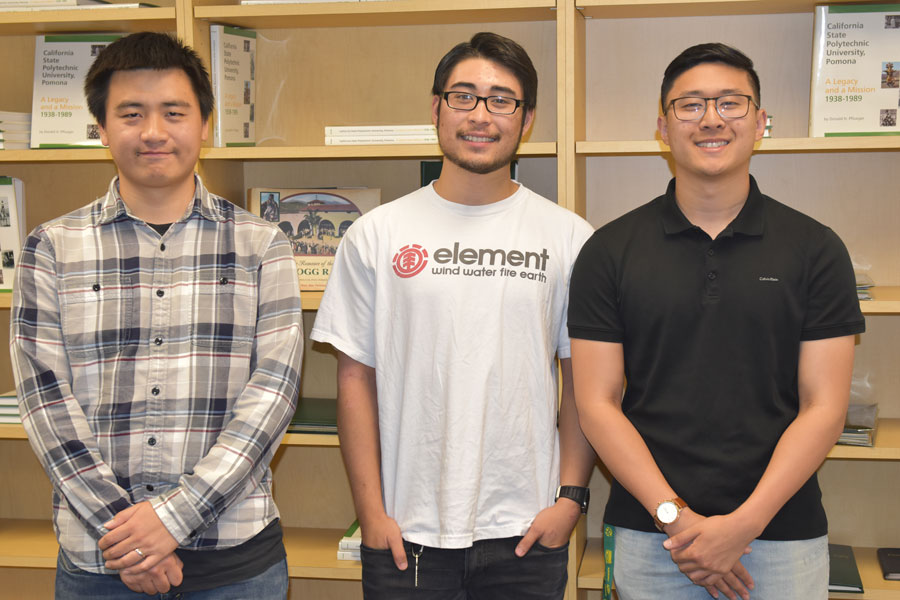Building a Better Microscope: the BioScope

(left to right) Chenghao Chen, computer science, Benjamin Aldrich, computer engineering, Jason Yeh, computer science.
In a small, nondescript room an interdisciplinary team of students from the colleges of design, business, engineering, and science are gathered at a workbench. Their enthusiasm is palpable as they work to build a better microscope.
Their goal is to create a quality product with 200x magnification that can retail for $40 or less. Currently, products with similar capabilities cost $150-$300. At that price most elementary schools can’t afford to buy a microscope for every student. The BioScope would change that.
“Our goal is that one day microscopes will be as plentiful as pencils in the classroom.” Ertan Salik said. Salik is a physics professor who was asked to collaborate with Erkan Ozkaya from the College of Business Administration on a partnership with NASA. Ozkaya is the director of the Cal Poly Pomona - NASA Business Startup Program which uses NASA technologies to create new products and ventures to commercialize them.
While the BioScope doesn’t incorporate NASA technology, the NASA team provided input on the project. They pointed the CPP team to a field microscope idea developed by Pacific Northwest National Laboratory that used low cost glass beads held by a 3D printed enclosure coupled with a cell phone. The phone’s camera allows users to view images on the screen.
“That design proved to be impractical to implement.” Ozkaya said, “The problem was that out of 100 or so beads, only one or two were usable but you may have to test 100 beads to find the one that works.”
The current BioScope still includes the user’s cell phone but incorporates better optics. Market research guided the design which is confidential due to copyright concerns. The form is familiar, fun, and easy to use.
At the weekly meetings all disciplines provide input on the team’s progress. At a recent meeting, the merits of leather versus synthetic material were discussed and issues of production cost were considered along with the logo design.
Computer science major Jason Yeh said, “It’s just like an actual business. The challenge is that the development cycles and expectations can be overwhelming. But solving the problems and making things work is a euphoric rush.”
Yeh and fellow computer science major Chenghao Chen are working with Benjamin Aldrich, computer engineering major, on the cell phone apps. Their first contribution was a custom photo gallery where users will save images. Their most recent effort has been the development of a focus stack. The software combines the sharpest areas of multiple images to create an optimum image.
To accomplish this the team started with Python code they converted to C++ and then to Android. Everyone on the apps team has experience in Android programming. “That’s what attracted me to this project.” Aldrich said. “It’s nice to work with a team that can actually do things. We’ve learned what it’s like to be on a development team, meet deadlines, and see it all come together.”
“Our focus is implementation, having a stable app with no bugs. That’s different from the business students whose main focus is efficiency.” Chen added.
Another feature the team is considering adding is a cloud-based photo sharing site where users can upload and share their images. But the programming team sees voice-activated photography as a priority as it will ensure there’s no vibration when the user snaps a picture.
“Ultimately we would like to incorporate artificial intelligence to recognize pictures. This could be used by doctors in the field or first responders assessing chemical threats.” Program Director Ozkaya said. “Research has shown that AI is about 3% more accurate than human experts.”
Even though the BioScope continues to be improved, an earlier 2017 version won the $10,000 first place prize in the Bronco Startup Challenge and a previous team received a President’s Discovery Fellow Award.
Students in the program enroll in an elective course to receive credit for their participation. “Even though it’s an elective, this is by far the heaviest work load of any class.” Yeh said.
“I don’t mind the work because it’s stuff we’re needing to learn.” Aldrich added.
Ozkaya believes the BioScope may be ready for market as early as next year.
